Let’s be honest… for people who love mayonnaise, there are no acceptable substitutes. It is the creaminess in our coleslaw and potato salad. It’s what makes a sandwich worth eating. So why not make a healthy mayonnaise?
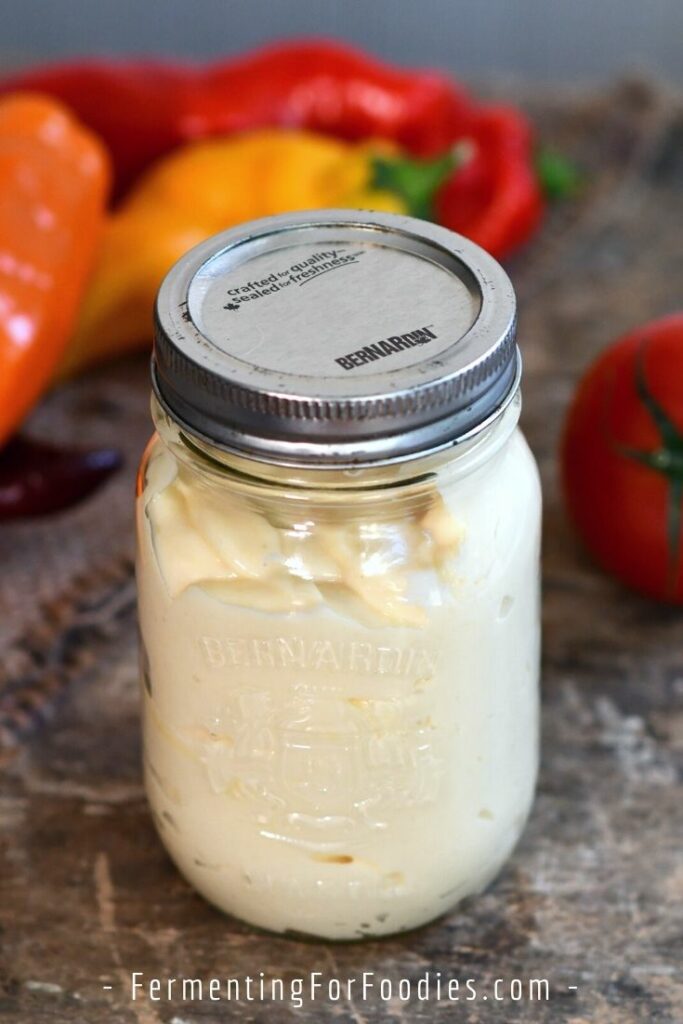
Why make mayonnaise?
Mayonnaise is a go-to condiment that you can find in the grocery store. Yet, it’s surprisingly easy to make. Here are the top reasons why you should consider making your own mayonnaise.
- Flavor: Homemade mayo is delicious, and it’s so simple to add extra flavors when you’re whipping everything together. And really, mayonnaise is all about flavor! See the section below for my favorite flavor additions.
- Healthier: Store-bought mayonnaise contains sugar, preservatives, and unhealthy fats. Making your own mayonnaise means that you can choose what type of oil to use, and you get to skip the sugar and preservatives. This recipe even has the option to add probiotics!
- Waste-free: Homemade mayo is waste-free. It doesn’t involve a glass jar or plastic tub; you can make exactly the right amount, avoiding food waste. It’s perfect for all your mayo needs including a healthy homemade dip!
- Easy: It’s as easy as whipping together a jar of salad dressing. It only takes about 5 minutes to make a large batch of homemade mayo.
10 Mayonnaise flavors
Homemade healthy mayonnaise naturally pairs with many flavors. Here are my favorite options. They can be added to 1 1/2 cups of already made mayonnaise or add them with the egg yolk instead of the mustard powder in the recipe below.
- Basil: 1/3 cup of finely chopped fresh basil, or 2 Tbsp of dried basil.
- Chive: 1/2 cup of freshly snipped chives.
- Lemon dill: 1/2 cup chopped fresh dill or 3 Tbsp dried dill and the zest of 1 lemon.
- Curry: 2 Tbsp curry powder.
- Roasted garlic: roast 1 whole head of garlic, then finely puree the cloves and add to the egg yolk. The cloves should be soft enough that you can puree them with the back of a spoon.
- Bacon: 1/4 cup of crispy bacon bits, finely chopped.
- Chipotle: 1 Tbsp of adobo sauce (from a can of chipotle peppers) and 2 tsp smoked paprika.
- Truffle: replace 2 Tbsp of oil with truffle oil.
- Horseradish: 1/4 to 1/2 cup of horseradish sauce, depending on how hot you want it.
- Honey mustard: 3 Tbsp of honey and 2 tsp of dry mustard (instead of the 1/2 tsp)
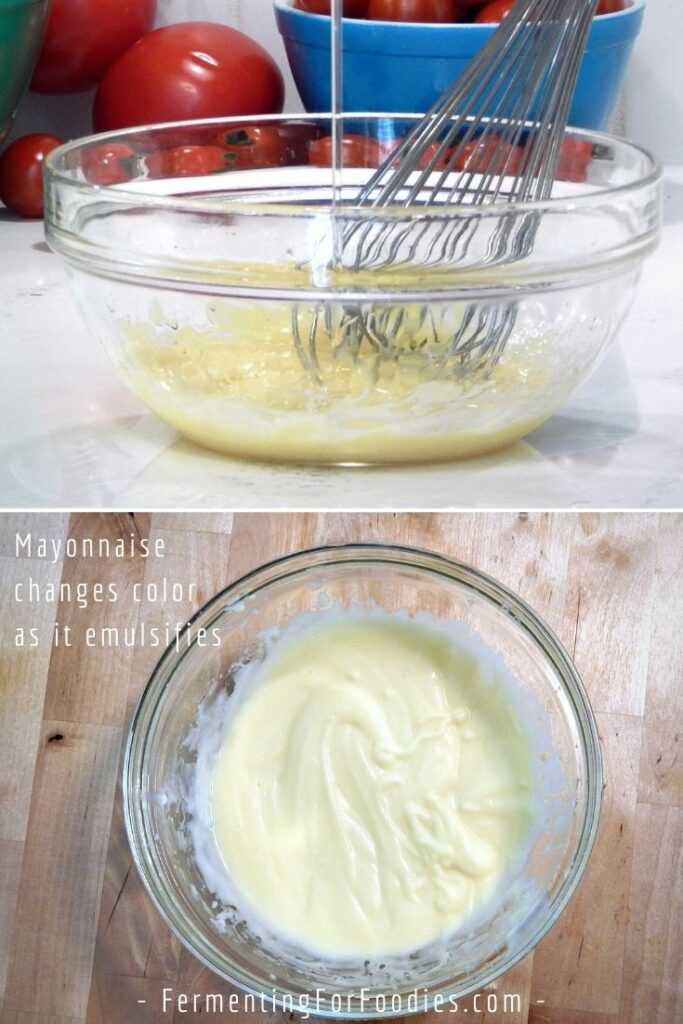
Fermented Mayonnaise?
I’m pretty into fermentation, however, I’m not sure I would leave raw eggs out on the counter to ferment for longer than a few hours. However, I do recommend using a probiotic culture in your healthy mayonnaise.
- Mayonnaise is an emulsion of fats and acids. While lemon juice is traditional, there’s no reason why you can’t use your favorite acidic culture.
- The recipe below uses ACV because it’s easily found in most grocery stores. It’s fine to replace it with well-fermented and acidic kombucha, or sauerkraut brine that is at least 4 weeks old (so it’s well-acidified).
- Adding a bit of culture to your mayo is not only a sneaky way to get some probiotics, it also acts as a natural preservative.
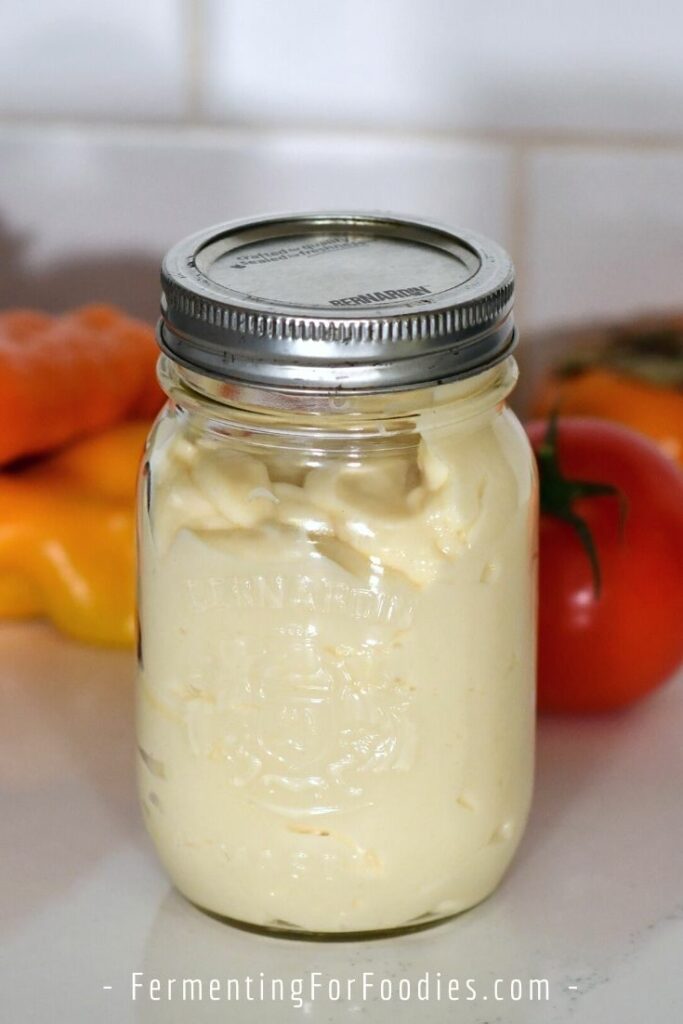
Healthy Mayonnaise
Healthy mayonnaise is sugar-free, preservative-free and you can use your favorite type of oil! This recipe even includes an option to add a dose of probiotics. Best of all, it’s easy to add flavors to homemade mayonnaise. See the section above for 10 delicious flavors.
- Prep Time: 10 minutes
- Total Time: 10 minutes
- Yield: 1 1/2 cups 1x
- Category: Condiment
- Cuisine: French
- Diet: Vegetarian
Ingredients
- 1 egg yolk
- 1/2 tsp fine salt
- 1/2 tsp dry mustard (or other flavors, see above for suggestions)
- 2 tsp freshly squeezed lemon juice
- 1 Tbsp apple cider vinegar
- 1 cup oil (see notes)
Instructions
- Place the egg yolk, salt, and mustard powder (and any other powdered spices) in a large bowl.
- Mix the lemon juice and vinegar in a small bowl. Whisk the egg yolk, and add half of the acids into the yolk mixture, whisking the entire time.
- Keep the whisking as you add in 2 Tbsp of the oil, and keep blending until the liquid starts to thicken and lighten. (See the photo above for an example). It’s important to get the oil and acids to start emulsifying before you add any more liquid. This initial emulsification is what holds the mayo together.
- Once the oil has started emulsifying, slowly pour in another 1/2 of oil.
- Next, add the rest of the acids, whisking the whole time.
- Continue whisking as you add the rest of the oil. It should all come together in a beautiful smooth emulsion. See the photo above for a picture of the change in color from yellow to white as it emulsifies.
- Leave the mayonnaise to sit out at room temperature for 1 to 2 hours so that the acid can kill any bacteria that might be in the eggs. It’s a natural way of preserving mayonnaise. Check out the notes to add probiotics and healthy fats to this mayonnaise!
Notes
- For a dose of probiotics, use ACV with a mother. For more details see the section above about fermented mayonnaise.
- I usually use sunflower seed oil, however, you can use any light oil that you want: safflower, canola, or corn. To add heavier oils (like avocado oil, olive oil, or flax seed oil), mix 1/3 cup of a heavier oil with 2/3 cup of lighter oil. The result is slightly heavier mayonnaise with a slightly green or tan tinge.
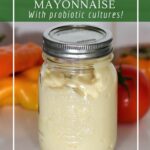
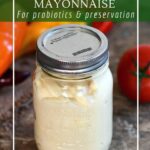
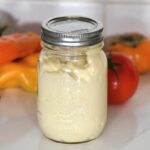
I havemt tried this recipe., you have some great ones that I will be trying. My go to mayonnaise is: 1 1/4 cup organic sunflower oil, 1 freshly squeezed organic lemon, 1 whole egg, 1 teaspoon mustard and salt to taste (I use pink salt) : add egg, mustard, salt and 1/4 cup of oil into a blender. Blend until creamy. Slowly add the remaining cup of oil while the blender is on. The slower you add it the creamer it is. Once you’ve added all the oil add the lemon juice while still blending and blend for a further 10-15 seconds. Delicious every time. Store in an airtight jar in the fridge for a week or so.
Interesting. Do you use the whole egg or just the yolk? Thanks for sharing!
Do you use the whole egg or just the yolk?
I only use the yolk… not sure about the other reader though!
I have seen many recipes that include the whole egg (white and yolk) – apparently, it’s a common way to make mayonnaise. I still prefer to use only the yolk though! Maybe one day I’ll try the whole egg.
Hi Emillie, I have not made your recipe for Mayonnaise yet – as i’m currently researching and looking for a very good, tasty – healthy recipe. I do take exception to your recipe as you are recommending seed oils. All seed oils (and even olive oil) will start to oxidize even before they hit store shelves. Seed Oils are very toxic to the human body. There are many many good doctors on youtube warning people about the consumption of seed oils. Thank you for listening
Thanks for sharing! What oil do you prefer? This recipe should work with any oil that is liquid at room temperature (so not coconut or butter).
This worked out pretty well as far as homemade mayonnaise though its a bit more liquid than I’m used to.
The consistency really depends on the emulsification. If you are making this by hand, you may need to beat the first batch of oil a bit longer, before adding the rest of the oil. Cheers, Emillie
I recently found your site and am thrilled at the fermentation recipes, as well as others.
I do have a problem with your printed recipes. They should contain the variations and storage/other information in the notes section. If I am printing a recipe, I obviously will not use the site, so there is no way of remembering what variations or other information you say to “refer to the notes.”
It’s encouraging to see another Canadian blogger, so keep it up!
Hi Laurie, I’m glad you enjoy the site! Hum… I’ve never tried printing a recipe off the blog so I didn’t know that the notes section doesn’t print. I also often have other notes in the section above the recipe. I actually try to keep the recipe steps shorter (while being as clear as possible) because it’s hard for online users if they have to scroll through a bunch of text in the recipe. However, fermentation has so many variations and extra details that I want to give as much info as possible. Beginners especially need all the info.
Maybe you could add a few handwritten notes after printing the recipe off? I’m a big fan of writing on recipes. Pretty much every cookbook I own has a few handwritten notes!
What’s your blog?
Cheers, Emillie
Hi Emillie! After the mayonnaise is done, how long can it be stored in the fridge? I’m newer to fermenting and have only made a couple things, so I’m still learning what the limits are. While I enjoy mayonnaise, I don’t necessarily much of it in a short amount of time (unless I’m making potato salad).
The longest I’ve kept it is 2 weeks. We usually make it for a specific dish (like potato salad or coleslaw) because it is hard to use up. Cheers!